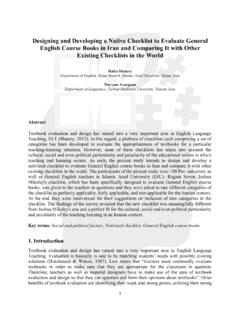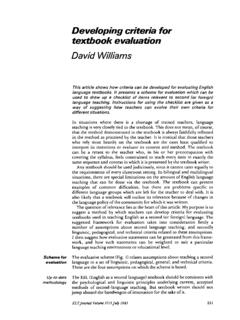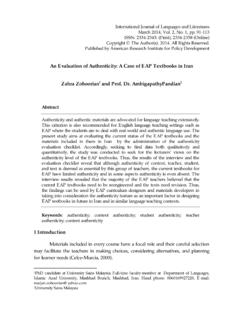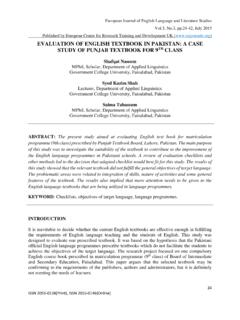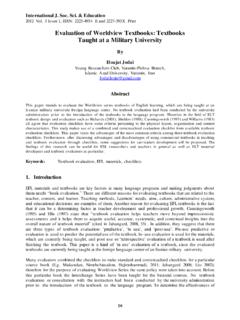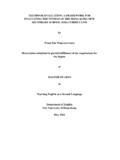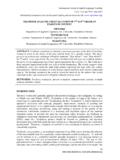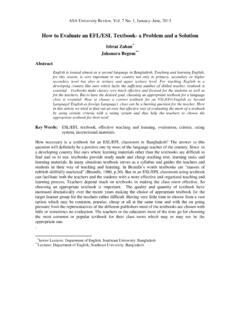Transcription of Textbook Evaluation: Looking at Prospect Series through ...
1 Research in English Language Pedagogy Author(s) 2020, This article is published with open access at RELP (2018) 6(2): 182-204 DOI: Textbook evaluation : Looking at Prospect Series through Teachers Perspective Sima Shahmohammadi* English Department, Faculty of Humanities, Urmia University, Urmia, Iran E-mail: Abstract Textbooks play a vital role in the realm of language teaching and learning particularly in formal contexts schools.
2 In the investigation reported in the current paper, the researcher employed an eclectic checklist derived from previously utilized frameworks aimed to evaluate the textbooks taught in Junior high schools in Iran Looking through teachers perspectives. To approach the aims of the study, 34 teachers from East and West Azerbaijan with 8- 28 years of teaching experience were asked to evaluate the textbooks on the basis of the provided checklist . Moreover, in order to gain a richer insight to their attitudes toward the textbooks, 8 teachers from the same provinces were interviewed to express their opinions with respect to strength and weak points of the textbooks as well as suggestions to improve the textbooks.
3 The results of the study depicted that pronunciation and task and activities are the aspects of the textbooks that are in need of more improvement and revision. However, vocabulary was the most satisfactory dimension of the textbooks. The findings of the study could help material developers in the process of editing and improving the textbooks. Keywords: evaluation , checklist , Junior High school, Prospect Series , Textbooks * Corresponding Author Submission date: 10 Nov, 2017 Acceptance date: 15 Apr, 2018 RELP (2018) 6(2): 182-204 / 183 1.
4 Introduction Among the four influential factors in language teaching and learning, namely, teachers, learners, context and textbooks, the role played by the textbooks cannot be neglected specially in foreign language contexts that are considered as the main source of linguistic input after the teacher (Razmjoo, 2010). According to Sheldon (1987), a Textbook can be considered as a published Textbook designed to aid learners in acquiring communicative and linguistic abilities. McGrath (2002) states that a Textbook is important since it sets the direction, content, and to a certain degree, how the lesson should be taught.
5 All materials utilized in educational settings should meet some specified criteria as well as attracting learners interest and attention to be fruitful (Tomlinson, 2001). Moreover, textbooks are designed to give cohesion to language learning and teaching process through direction, support, and specific language-based activities to provide learners with more practice (Mares, 2003) and facilitate and hasten learning process (Cunningworth, 1995). Foremost, textbooks provide teachers with the chance to have access to already-made sources to focus on in language teaching and save time and energy (Edge & Wharton, 1998).
6 In spite of unremitting effort devoted to English teaching, neither teachers nor students were satisfied and convinced with the result of the English instruction. Maybe the most crucial factor in this regard was the textbooks. Fortunately, during the last six years a great shift has occurred in the educational system with regard to the English teaching and learning anticipating the new Series to overcome the limitations of the former Series . The current study intended to evaluate a recently compiled and added English Textbook to the educational system.
7 The quality and role of textbooks might be so important that they can affect the success or failure of the students and / or teaching program (Mukundan, 2007). According to Sheldon (1988), Textbook evaluation cannot be ignored due to two key reasons. The first deals with smoothing the teachers way in selecting an appropriate Textbook . Furthermore, familiarizing teachers with the Textbook , the evaluation makes strength and weak points of them clear and known. evaluation , as a dynamic process, deals with appropriateness and suitability of the existing materials (Rea-Dickens and Germaine, 1992) and can be regarded as a useful device for teachers and material developers.
8 Additionally, it may provide modification and novelties in teaching and learning situations. Moreover, Ellis 184 / RELP (2018) 6(2): 182-204 (1997) proposed three types of Textbook evaluation , namely, pre- use , in- use and post- use . An evaluation with pre- use or predictive purposes aids teachers and instructors in selecting an appropriate Textbook among the abundant number in the market. The second type of evaluation , help teachers to find the strength and weak points of the Textbook as it is being taught.
9 Finally, based on the post- use evaluation also known as retrospective evaluation , teachers reflect upon the Textbook after its use in particular instructional situation. Having the objectives and aims of the present study in mind, it can be claimed that this evaluative investigation corresponds with the second type of the evaluation set off by Ellis (1997) , in- use evaluation . William (1983) states that evaluation relates assumption about teaching a second language to a set of linguistic, pedagogical, general, and technical criteria.
10 Furthermore, it supports teachers to gain convenience, precise, organized and circumstantial perception into the global natural surroundings of Textbook materials. In addition, Tomlinson et al (2001), claim that Textbook evaluation is an applied linguistic activity through which the effect of material on people utilizing it is scrutinized by teachers, supervisors, administrators, and material developers. Considering material evaluation as a way of action research, Tomlinson (1996) states that evaluation aid us to understand how the material works.
